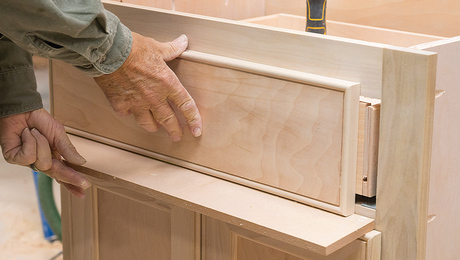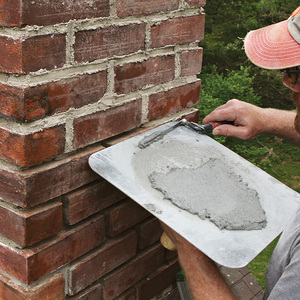Caulk before or after priming int.trim?
Old walls, new window trim, and we are ready to caulk and paint – or paint and caulk… We have siliconized acrylic latex caulk but wonder whether its better to have primer on the trim before caulking. Any recommendations?



















Replies
I would use a latex caulk between the trim and the walls, and wood filler for the nail holes. I like the Elmers filler that comes is short fat toothpaste tubes. It fills nicely, doesn't shrink, and sands easily. And I would caulk and fill before prime. If you use your siliconized caulk, be sure it is paintable.
"When asked if you can do something, tell'em "Why certainly I can", then get busy and find a way to do it." T. Roosevelt
I'd prime first. Calk smooths out better on paint than raw wood.
Prime first, then caulk, then finish coats. Caulk adheres better to primer than to wood.
Prime first,then caulk
mike
That's 3 to 1 for prime first. How come so many of you have it backwards? :)
"When asked if you can do something, tell'em "Why certainly I can", then get busy and find a way to do it." T. Roosevelt
"That's 3 to 1 for prime first. How come so many of you have it backwards?"
Irregardless of adherence or chemical leaching, I'd prime first as a painter/installer for speed's sake. Much quicker to prime trim on horses than on the wall tight to windows I'm not painting for one. I backprimed my trim but I know nobody does that anymore, but they all b$tch about tight joints opening down the road.
mb... we not only backprime... we end prime all trim..
a finish gun in one hand... and a paint pot in the otherMike Smith Rhode Island : Design / Build / Repair / Restore
I try to sell builders on that all the time. I've yet to have one bite.... even the quality ones. I did get the GC I'm currently working for to hit the back side of the mahoghany I'm installing next week with Penofin before we start and we'll whack all our cuts with it before nailing it off. It's a start. Even still, I glue all joints on exterior trim with Titebond II or III.... that's gotta help some.
so whats better for end cuts when trimming out ? a dab of primer.or a dab of glue. doing boths kind of slow.what do we do?
Ok, I'm a little dense. I juse realized that I answred based on the last painting I did. I was helping a friend on one of his jobs ... I was just the hired hand ... he supplied all the material etc. Cheap job ... pre-primed mdf trim. Scope included applying trim around windows and cased openings to make them look a litttle nicer, and repainting the entire room. I nailed the trim, caulked it, then primed the pre-primed mdf crap, then painted.
But you're all right. Normally I prime and apply one color coat before hanging, then caulk and touchup.
"When asked if you can do something, tell'em "Why certainly I can", then get busy and find a way to do it." T. Roosevelt
I always primer then caulk and as I was thinking over this thread earlier today I had to read the label on a can of Glidden's Ultrahyde Gripper primer and it said...caulk then prime.
as Buddha said to the hotdog vendor .... "make me one with everything"
Prime first. The bare wood will leach compounds out of the caulk causing it to dry up.
At least, that's what I've repeatedly read in various posts on BT over the years.
Rich Beckman
Another day, another tool.
prime, caulk/fill, paint
our favorite caulk is DAP 35 year Acrylic latex plus silicone
or, for more severe locations DAP 50 year... which they call an "elastomeric latex"
Why don't you prime and paint the trim before installing it? It's never going to get easier than having the trim waist-high on sawhorses. Zero runs, zero drips onto finished floors or carpet and no one will be able to cut in a line better than what you'll achieve. The only post-installation painting needed will be nail holes and mitered/coped joints.
Hanging primed and not finished trim gives the trimmer some leeway to work with the trim, sanding joints and such. A pre-finish install (and we have done prefinished painted trim) is a different animal, requiring higher grade trim milling and more time for the installer to backsand or shim joints. Primed trim can be hung and then joint sanded if necessary. In commercial work we deal with steel studding so it requires trim screws often enough and even a trimscrew hole should be over filled and sanded back flush. And don't even get me started on wavy drywall work. As far as glue in joints, I insure that the whole joint, both sides, is wet with glue and wipe the squeeze out away with a wet rag.
All good points, mbdyer. I guess whenever I reply to a thread I should always mention that I'm not a pro, but a DIYer that can take the extra time (please don't ask my wife how much extra time...) to backsand, shim, etc. I'm anal enough that I'll take a few days to fill in waves in the drywall with compound before painting, so my walls are relatively straight when I install baseboard or trim molding. I'll always shim baseboard molding so there's something solid to nail it to and so coped or mitered joints line up nice and square.My finished work looks perfect, but the time cost is exorbitant. I'd better not quit my day job...
Our standards are similar, we just get faster with experience and practice. Plus the looming spectre of layoffs!
On all the door units (exterior) I've been building... all dado'd glued & screwed... plane ,cut & sand , fill voids (smoothwood filler) assemble... fill nail holes... sand... prime... caulk... sand... paint... install... back prime everything, end prime and I'll even wipe some caulk on the end cuts... pretty much finished once the whole unit is set in place...
p
If you really want a job that lasts, and you're willing to take a little extra time, the true professional method is prime, caulk, then spot prime caulked areas, then 2 topcoats. If all your other prep. was thorough, and you use good quality products, you'll get maximum life out of the job. Speaking from my own personal experience, spot priming caulked areas doesn't take much time--but it is an extra step, obviously.
Prime then caulk
The primer bonds to the wood better than caulk does. but if you fill aniul jholes with wood filler, do that first, then sand, then prime, then caulk. If you use spackle in the nail holes, prime first.
Welcome to the
Taunton University of Knowledge FHB Campus at Breaktime.
where ...
Excellence is its own reward!
Wow! Talk about differing opinions!
Glad I didn't ask this one.
BTW, I prime before caulking.